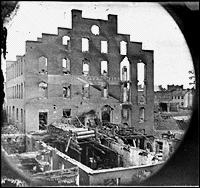Civil War Photographs Home Page
Time Line of The Civil War, 1865
1861 |
1862 |
1863 |
1864 |
1865 |
Other Photographs
This time line is drawn largely from the work of Richard B. Morris, in particular his Encyclopedia of American History.
After Admiral David D. Porter's squadron of warships had subjected Fort Fisher to a terrific bombardment, General Alfred H. Terry's troops took it by storm on January 15, and Wilmington, North Carolina, the last resort of the blockade-runners, was sealed off. Timothy H. O'Sullivan promptly recorded the strength of the works and the effects of the bombardment.
January 1865 -- The Fall of the Confederacy.
Transportation problems and successful blockades caused severe shortages of food and supplies in the South. Starving soldiers began to desert Lee's forces, and although President Jefferson Davis approved the arming of slaves as a means of augmenting the shrinking army, the measure was never put into effect.
February 1865 -- Sherman Marches through North and South Carolina.
Union General Sherman moved from Georgia through South Carolina, destroying almost everything in his path.
February 1865 -- A Chance for Reconciliation Is Lost.
Confederate President Jefferson Davis agreed to send delegates to a peace conference with President Lincoln and Secretary of State William Seward, but insisted on Lincoln's recognition of the South's independence as a prerequisite. Lincoln refused, and the conference never occurred.
 |
Ruins of paper mill; wrecked paper-making machinery in
foreground
Richmond, Va.
April 1865
|
April 1865 -- Fallen Richmond.
On March 25, General Lee attacked General Grant's forces near Petersburg, but was defeated -- attacking and losing again on April 1. On April 2, Lee evacuated Richmond, the Confederate capital, and headed west to join with other forces.
Alexander Gardner and probably other photographers made a splendid record of the Confederate capital, desolate after the evacuation of April 2 and the fire which raged along the waterfront but fortunately had stopped short of Thomas Jefferson's capitol. The photographs are arranged in a kind of guided tour of the city, first along the James from Rocketts westward to the Tredegar Iron Works, inland to the capitol and its environs, and on to the residence of President Jefferson Davis. Present-day street numbers have been provided where possible.
The Lincoln administration was determined to make the capital safe from attack by ringing the city with a chain of forts manned by substantial garrisons of artillerists and other troops. The sequence of photographs starts with the forts on the Virginia shore (in alphabetical order, since hardly anyone today would be familiar with their locations, mostly long since submerged by city or suburbs), follows with defenses north of the Potomac (in the same order), and ends with a number of garrisons or local military units.
April 1865 -- Surrender at Appomattox Courthouse.
General Lee's troops were soon surrounded, and on April 7, Grant called upon Lee to surrender. On April 9, the two commanders met at Appomattox Courthouse, and agreed on the terms of surrender. Lee's men were sent home on parole -- soldiers with their horses, and officers with their side arms. All other equipment was surrendered.
April 1865 -- The Assassination of President Lincoln.
On April 14, as President Lincoln was watching a performance of "Our American Cousin" at Ford's Theater in Washington, D.C., he was shot by John Wilkes Booth, an actor from Maryland obsessed with avenging the Confederate defeat. Lincoln died the next morning. Booth escaped to Virginia. Eleven days later, cornered in a burning barn, Booth was fatally shot by a Union soldier. Nine other people were involved in the assassination; four were hanged, four imprisoned, and one acquitted.
Secretary of War Edwin M. Stanton's fanatical insistence on secrecy was relaxed sufficiently to allow this remarkable documentary series to be made at Ford's Theater, the Navy Yard, and the Arsenal. Why the photographer chose Howard's Stable instead of Pumphrey's or Naylor's must remain unexplained.
April-May 1865 -- Final Surrenders among Remaining Confederate Troops.
Remaining Confederate troops were defeated between the end of April and the end of May. Jefferson Davis was captured in Georgia on May 10.
The Army of the Potomac paraded on May 23, and the Army of Georgia on May 24. Unfortunately most of the photographs, thought to have been taken by Brady himself, fail to distinguish either the unit or the day.
August - November 1865
The notorious superintendent of the Confederate prison at Andersonville, Georgia, was tried by a military commission presided over by General Lew Wallace from August 23 to October 24, 1865, and was hanged in the yard of the Old Capitol Prison on November 10.
1861 |
1862 |
1863 |
1864 |
1865 |
Other Photographs
Civil War Photographs Home Page

